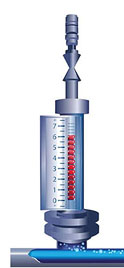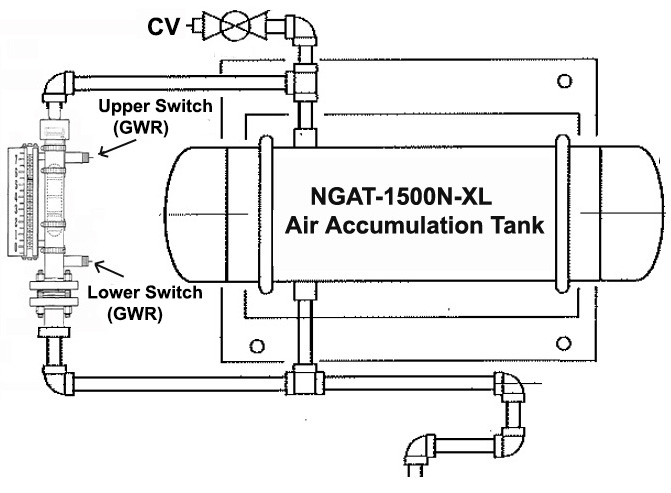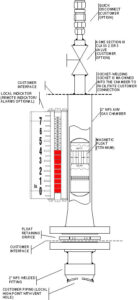Air Traps (NGATs)
- Home
- Air Traps (NGATs)
 Nuclear Grade Air TrapTM – (NGATTM)
Nuclear Grade Air TrapTM – (NGATTM)
Our flagship product is the patented Nuclear Grade Air Trap – or simply just called the NGAT (pronounced: En-Gat). Our patented technology was first introduced at the VC Summer station, this 2012 TIP Award winning (“Top Industry Practice”) technology is now being installed in a wide variety of locations in both BWRs and PWRs at numerous utilities. The technology is also applicable to the newer SMRs.
In order to ensure the continued safe operation of power generating stations, the NRC issued Generic Letter GL08-01 which instructs every U.S. power station to ensure that there is “no air” in any of their safety related fluid systems.
Air (gas voids or “air pockets”) has the ability to render the Emergency Core Cooling System (ECCS) and other safety systems inoperable. If a gas void within a pipe enters a pump, the pump could fail – and thus the nuclear plant’s emergency cooling system could fail.
To address this critical problem, NUCCORP designs and manufactures the NGATTM. The NGATTM is an innovative device that accumulates, measures and allows nuclear plant operators to eliminate unwanted air/gases in otherwise liquid-filled safety-related fluid systems.
Scroll down or click a section title to review the NGAT Links Below:
Gas Voids accumulate and are trapped in the NGAT, the volume of trapped gas is indicated, and when the trap is full the valve is actuated and the gas void is eliminated.

Accumulate. Indicate. Eliminate.
It is the law!
What is the NGAT?
The NGAT consists of a vertically mounted stainless steel chamber into which a seismically qualified and specially designed Titanium, magnetic float is inserted. A magnetic indicator (external to the pressure boundary) is attached to the chamber. The indicator follows the magnetic field produced by the float, thereby providing constant indication of the air/water level interface. Also, there are static retainers inside the chamber that serve as travel stops for the float and also serve as datum points. Thie allows for the minimum required liquid levels to be determined via calculation. The determination of the minimum allowed indicated level sets the initial plant conditions which must be maintained to ensure the air/water level stays above the main piping, following postulated plant design events (i.e., LOCA, etc.). When actual level in the chamber is above the minimum allowed, during normal plant operations, then that portion of the subject system, associated with the local high point where the NGAT is installed, is “full”, by definition.
NGAT Features and Benefits
- Provides a means for showing continuous, literal compliance with station Technical Specifications regarding ECCS Systems being “full”
- Allows for removal of air/gas before it has a chance to enter main safety-related piping
- Eliminates need for periodic, random venting by providing a continuous indication of air/gas
- Indication can be local, remote or both
- Eliminates labor and time-intensive UT inspections and promotes ALARA principles
- Air/gas can be removed without elevated platforms or scaffolding
- Simple and reliable passive design. No Active components
- Design allows for easy retrofit of existing conventional vents
- Designed and built to each utilities needs an a per location basis
- Ten (10) Years of flawless operation in the fieldwith ZERO need for UT
- Built under an exacting ASME NQA-1 program to ensure highest quality is achieved in each design and each unit
- Available as:
- NGAT – Non-Stamped, Safety-Related Nuclear Grade Air Trap. Available in 150 and 600 lb “Flange Class” sizes. Machined from solid forgings. (stocked for quick-ship)
- NGAT – ASME N-Stamped, Safety-Related Nuclear Grade Air Trap. Available as 150N, 600N and 1500N 1500N-XL sizes.
- NGAT-1500N-XL – Modular, high pressure large custom volume, wall-mounted tank NGAT (ASME N-Stamped)
How the NGAT Works
The NGAT is intended to be installed at local high-points in ECCS and other ESF systems If, or as, air/gas accumulates at these local high points, air rises into the chamber. The water is displaced back to the RWST or VCT as is the case. When this occurs, the water level and thus the float drops. The water level can be determined by any combination of float/level indicator, by guided wave radar (GWR) or by magnetic reed switches. When a predetermined low level is reached, the operator will open the vent valve, which vents off the air/gas while filling the chamber with water. Then, the indicators are checked periodically, according to the operator rounds. When air/gas accumulation is detected, a “tracking” condition-report can be entered into the plant’s corrective action program and then the NGAT can be vented and filled to ensure continued OPERABILITY.
NGAT Cycle Animation Video:
This is a cut-away animation that shows how gas voids rise into the NGAT and are trapped by their own bouyancy in the NGAT. It show how the magnetic float falls with the liquid level. It then shows how the indicator (which is outside of the pipe) follows the magnet showing the liquid level visually. Finally, it shows how the NGAT is manually vented. Remote indication with reed switches and remote valve actuation (MOV or AOV) are optional.
NGAT Technical Downloads: (Left-Click to View, Right-Click to Download)
- Brochure – NUCCORP’s Nuclear Grade Air Trap
- 2012 TIP Award (Top Industry Practice) Brochure
- Technical Data – NGAT-150N, NGAT-600N and NGAT-1500N-XL
- NGAT Paper presented at 2014 Spanish Nuclear Society Reunion in Valencia, Spain
- NGAT White Paper Rev 8
- NGAT Frequently Asked Questions Rev 5 (update pending)
- NGAT Installation Pictures with Comments
- Industry Solutions Comparison Chart Rev 1.0
- Alternative Methods of Detection and Removal of Gas Voids Rev 6.0
- NRC Generic Letter 2008-01 (GL08-01)
- Tech Specification Task Force Proposal (TSTF-523 Rev 2) as accepted by the NRC
- Federal Register listing the GL-0801 becoming US law (January 15, 2014)
NGAT-1500N-XL Schematic Diagram
Our large volume, ASME N-Stamped NGAT has options for both local indication and totally remote indication and operation using either guided wave radar (GWR) or reed switches. This system is especially useful in high radiation areas and/or areas with above average gas void volumes.
With many assembly options, the NGAT-1500N-XL is a #1500 lb class system that can be mounted on a wall, on the floor, to other equipment or on another floor – as long as the tank is mounted above the system pipe where the gas voids collect.

